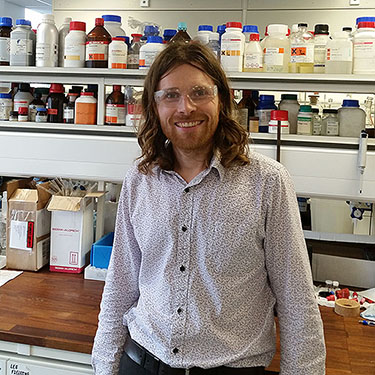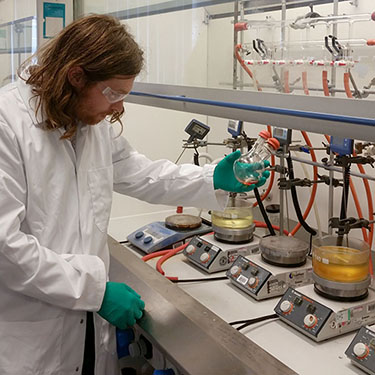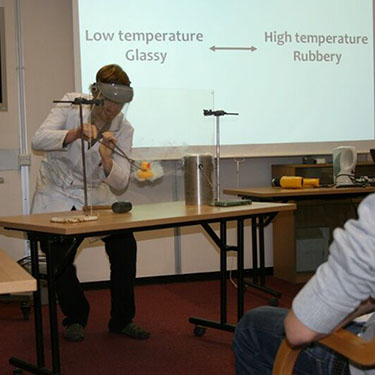#MondayMaterials Episode 24 – Dr Steve Edmondson
Meet the Department 15th August 2016
Hi all. #MondayMaterials is back. Thanks for your patience during a busy period caused by holidays and jam-packed schedules.
We’re here now, though. And Steve Edmondson, a member of the Polymers, Composites and Carbon Research Group, was definitely worth the wait:
Hi Steve. Thanks for talking to us. Could you please describe your research, for the layman, in ten sentences or less?
So I use chemistry to make and modify polymers or plastics or macromolecules. And I also use chemistry to modify the properties of surfaces. And actually, there’s the overlap of those two things as well. I use chemistry to modify surfaces by attaching polymers and polymer coatings to them.

This is important because, very often, we want to separate out the bulk properties of a material (is it strong, is it stiff?) from the surface properties (how does it interact with the environment?).
And being able to make and modify polymers myself gets me involved in all sorts of different areas. In particular, a big one at the moment is 3D printing. With some 3D printing techniques, you actually do chemistry within the machine to make solid polymer objects.
And how can your research benefit the public?
Modifying surfaces is very important because the surface of a material is how it interacts with the environment; with the outside world. For example, with a material that’s going inside the body you might want the material to be able to respond to that in a certain way. Or to be able to ignore it completely.
If we’re blending two different things together to make a composite, if we’re putting graphene into a polymer for example, modifying the surface of the particles that we’re putting in, we can control whether they mix well or whether they clump together.
Making new types of materials for 3D printing is very important because 3D printing, or additive manufacturing to give it its proper name, really needs to progress beyond the point where we’re just making prototypes or parts to look at. We need materials that have good properties or have functional properties. And being able to inject a bit of chemistry thinking is really important for developing that technology.
Sounds exciting, Steve. So how did you first get interested in your research area?
So I come, originally, from a chemistry background. I was really interested in chemistry at school. And for my degree I did a Natural Scientist specialising in Chemistry, and the real sort of detailed chemistry that, let’s say, a pharmaceutical company would use to make new drug molecules. That’s a real intellectual challenge – chemistry has this toolbox of chemical reactions people use to make things.
But, with apologies to my colleagues who work in this area, the practical side of doing organic chemistry is quite repetitive. It’s using only a few techniques, mostly purifying things. Whereas when I had the opportunity to move into materials, polymer chemistry, for my PhD, it looked like you had the opportunity to work on a much wider range of techniques. You use lots of different characterisation tools, lots of bits of equipment. You use chemistry and science from all across the spectrum. And that really appealed to me.
Going back a bit further, then, could you tell us who or what first inspired your interest in science?
My parents were very supportive of my interest in science: I had chemistry sets, electronic kits, and computer programming as a kid.
And coming from the North West of England, you’re surrounded by chemistry. You almost can’t open your curtains without seeing an oil refinery or a chemical plant. And Unilever was just around the corner. So in school we had some really great chemistry teachers who had some really great stories and real world experience. And also, they weren’t afraid to do demonstrations in school.

So coming from this area of the world really fired my interest in chemistry.
And what about your other interests? What do you get up to in your spare time?
Well up until about two and a half years ago, I spent a lot of time learning Chinese. In science we get people from all over the world but these days the language that is most common, I think, is Chinese. So it seemed like a good idea to try and learn it. It takes a long time to learn a language, and now having two young children, I have a lot less time. So I guess they’re my hobby now.
Well they’re a good hobby to have. One last question, then: can you tell us how being here in Manchester has helped your work and research?
Well Manchester is a great university for meeting lots of people from different disciplines. I’ve had lots of excellent new collaborations since I started working here. The access to equipment and facilities is really world class, you know. There are a lot of characterisation techniques which I can use here. And for my work that’s really important because although I’m doing chemistry, you lose a lot of the characterisation techniques, the analysis techniques, that a chemist would normally use. So instead you have to use lots of different techniques, and almost like a puzzle, like a detective story, you have to pull that all together. Manchester is really fantastic for that.

Also, just within our department as well – we have a really wide range of expertise. A really wide range of skills. It’s been really stimulating to work here and have those discussions about science.
Thanks for chatting to us, Steve. And what a nice point to end on. This is definitely a great place for discussions about science!
And to the rest of you, thanks for returning after the brief hiatus. You won’t have to wait as long next time. In just 3 weeks #MondayMaterials will return with the wonderful Phil Withers!
3D PrintingChemistryGrapheneMaterials SciencePolymersSchool of MaterialsThe University of Manchester





Leave a Reply
You must be logged in to post a comment.